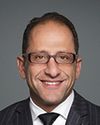Thank you very much for the invitation to speak today.
My name is Naseem Mithoowani. I am a lawyer practising in Toronto, Ontario.
As some of you may know, I am also one of the individuals who initiated human rights complaints in 2008 against Maclean's magazine for having published a feature article entitled “The future belongs to Islam”, authored by Mark Steyn. Maclean's, at that time, was our only national news magazine in an era when social media hadn't yet taken off. The article, therefore, garnered a fair amount of attention.
lt described Muslims as being engaged in a nefarious plot to take over western democracy as we know it. lt insinuated that all Muslims were guilty either by being directly involved in violence or by supporting the goal silently. Muslims living in the west were demonized as “hot for jihad” and as breeding like “mosquitoes” for the sole aim of supplanting the western populations where we lived but with whom we shared no allegiance. Muslims were portrayed as inherently violent and deceitful.
The Muslim community felt the harm of these words in their bones. This was a call to action for the west to wake up to the threat of Muslims living among them. lt was, in essence, asking Canadians to view their Muslim neighbours with suspicion.
We also found 21 articles printed in the previous two years in Maclean's that contained the same anti-Muslim themes, referring to Muslims as “sheep-shaggers”, “global security threats”, “barbarians” and prone to frenzy. One memorable piece even suggested that the CBC comedy Little Mosque on the Prairiewas part of a conspiracy to distract the watching public from the security threat that Muslims posed by instead promoting them and portraying them as good and friendly community members.
We found exactly zero counter articles or critical analysis in response.
We sought a meeting with Maclean's to propose that they consider running a counter piece to address the allegations made in Mr. Steyn's article. More and better speech, we reasoned, was a win for all parties involved. It was only when we were completely shut out by Maclean's that we filed human rights complaints. The very fact that we had done so, in and of itself regardless of the outcome, was seen as proof of abuse, justifying the repeal of section 13 by the Conservative government at the time.
With the benefit of hindsight, I think there are very few people who would today believe that we had no reason to be alarmed over the content of the publication in question.
Those who peddle the rhetoric of a Muslim takeover don't care that the claim contains no truth. Suspicion and fear of Muslims sells. The idea that Muslims are actively trying to subvert western democracy is a warning that people heed, sometimes with horrific consequences. ln fact, we now know that the claims of western demographic decline and supposedly astronomical birth rates of Muslims are a staple in the modern white nationalist movement, usually framed in terms of an invasion, cultural replacement or white genocide.
Indeed, shortly after our complaints were dismissed, the very article that we alleged was hateful was specifically quoted in the manifesto of a white supremacist, who then went on to kill 77 people in Norway in 2011. He justified his actions and his violence as a form of resistance against the inevitable Muslim takeover that Steyn and others were warning against.
This idea of a Muslim takeover of the west has also played prominently in the motivations of the killing of Muslims in Quebec and New Zealand.
Particularly after the deadly attack in New Zealand, even those who were most ardently in support of repealing section 13 following our complaints have paused to reconsider. Professor Richard Moon, for example, was a thought leader in the call for the repeal of section 13. He was commissioned by the government to write a report regarding section 13, and in that report he recommended repeal.
He has since had the opportunity to revisit the Maclean's complaints in a very recent blog. In it, Professor Moon expressly acknowledges that the outcry over our complaints was unwarranted. He states that in light of the rising tide of violence against Muslims, it is not surprising that Steyn's rhetoric has been cited by those who wish to cause Muslims harm.
The truth, then, of the Maclean's complaints, and the controversy surrounding them, is that the Muslim community attempted to use section 13 to call out, 12 years ago, the very same hateful propaganda of a mass Muslim conspiracy theory that we are seeing as influencing mass murder today. The unfortunate lesson that I take out of my experience with the Maclean's case is that we, as a society, were not able to get ahead of the rhetoric at that time and call it out for what it is.
Section 13 does not unduly restrict freedom of expression. It creates a tool to identify and address speech which harm far outweighs any potential benefit. This is in line with our societal values. In Canada, as opposed to other jurisdictions, we simply do not recognize an unlimited right of free expression. Rather, we recognize that legitimate restrictions may be placed on all rights and freedoms, including freedom of expression in a free and democratic society. Hate propaganda is a harm that needs to be confronted, since it shuts down dialogue by making it difficult or impossible for members of vulnerable groups to respond, thereby stifling discourse.
Since the repeal of section 13, communities have been left open to attack. It is my first recommendation to this committee, therefore, that section 13 be reinstated.
However, my experience with the Maclean's complaint leaves me to believe that section 13 alone is insufficient. Section 13 requires individuals to do the heavy lifting of making and carrying complaints. In addition to the financial and time commitment in making and carrying on complaints, those who initiate complaints are vulnerable to personalized targeting. When we made our complaints, for example, as law students just beginning our careers, we were called "legal jihadists", "terrorists", "sock puppets", and accused of using the tools of western democracy to dismantle it.
Instead of seeing Steyn's portrayal of Muslims in the west bent on subverting democracy as the dangerous trope that it is, our actions and complaints as Muslims were viewed through this very lens. We were accused of using democratic tools, including section 13, to subvert western values.
Confronting hate speech is in everyone's interest. That burden should not be placed on the shoulders of a few. It aligns with a better democratic system by ensuring that all voices are included. We cannot afford to download the entirety of the financial and emotional burden of standing up to hate onto vulnerable groups.
My second recommendation is therefore that the committee considers the creation of a body which could intake complaints and carry them forward. I want to be clear that such a body should not disallow individuals and communities from taking personal carriage of complaints where they elect to do so, but should be seen instead as an alternative and complementary channel.
I wish to conclude my remarks by stressing that reinstating section 13 is a vital first step towards combatting online hatred, but it is insufficient in and of itself. We need more tools and partnership amongst all industries, communities and civil society in order to address the problem effectively. The technology and reach of the Internet makes Canada a far different place from when we initiated complaints against the printed Maclean's magazine in 2008. We need creative solutions in response, which should include but not be limited to the reintroduction of section 13.
I thank you for your attention, and I look forward to answering your questions in our next segment.
Thank you.




